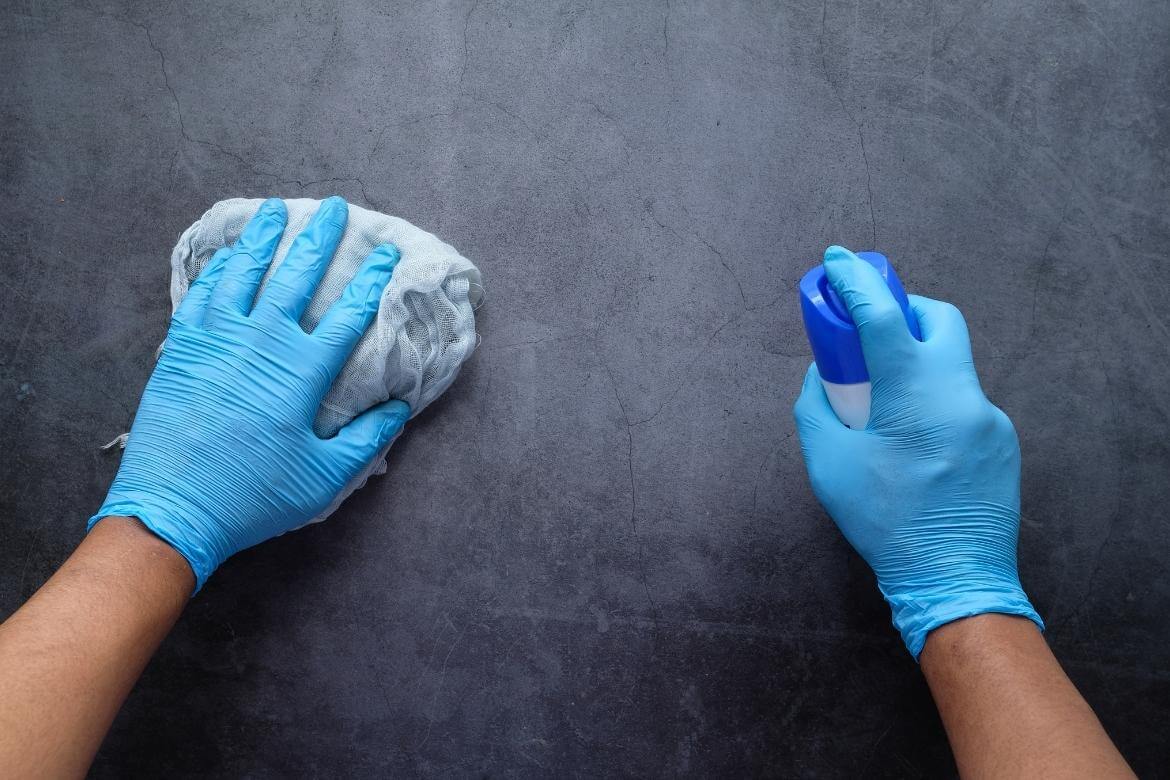6th August, 2025
What Is A COSHH Assessment?
The COSHH regulations require you to do a COSHH assessment when using or creating hazardous substances. Most businesses will need them. But what is a COSHH assessment, its purpose, and what does this document need to include?

A COSHH assessment is a health and safety document required by the Control of Substances Hazardous to Health (COSHH) Regulations. The COSHH regulations apply to any hazardous substances used or produced at work.
Employers have legal health and safety responsibilities to protect their employees and others from harm. Substances that are hazardous to health can cause harm, and the COSHH regulations aim to prevent this.
A COSHH assessment is a type of risk assessment specifically for the use or production of a hazardous substance. This assessment is needed to identify the hazards associated with the substance and to assess and control the risks.
COSHH assessments are a legal requirement under the Control of Substances Hazardous to Health (COSHH) Regulations.
- An employer shall not carry out work which is liable to expose any employees to any substance hazardous to health unless he has—
- made a suitable and sufficient assessment of the risk created by that work to the health of those employees and of the steps that need to be taken to meet the requirements of these Regulations; and
- implemented the steps referred to in sub-paragraph (a).
Since you can find hazardous substances in nearly every different kind of business, COSHH assessments are required in nearly every business. Your workplace should have COSHH assessments in place for any hazardous substances used (or created) at work. Hazardous dust, fuels, inks, paints, chemicals, and everyday cleaning products can all be a risk to your health.

A wide variety of hazardous substances need to be COSHH assessed, including chemicals, mixtures, biological agents, dust and fumes. COSHH covers any substances that create a health risk because of their properties. So to comply with COSHH, it's important to be aware of the substances you use and create at work, and assess how you use them.
What does a COSHH assessment tell you?
A COSHH assessment tells you about the hazards involved with a substance, and what precautions you need to take to stay safe while working with it.
Your COSHH assessment should not just be a paperwork process. Yes, a COSHH assessment is a legally required document, but it is worth much more than just the paper (or electronic form) it is written on. The purpose of a COSHH assessment is to assess the risks and decide on the sensible steps needed to avoid ill health to the workers exposed to the substance.

Throughout the COSHH assessment process, you can look at how you manage the substance. How you use it, handle it, store it, even dispose of it. How can you control exposure at each step? What do you need to do to make it safe? What are you doing now that could be better?
Your COSHH assessment should tell you (and others) about the hazards that are present and the risks involved with the substance. It should provide details of the actions taken to protect the health of the people exposed to the substance(s) used or produced in the process. It is also a way of communicating COSHH control measures and emergency arrangements.
You can base your COSHH assessment on the information you have gathered about the substance. It will usually start with the safety data sheet provided to you by the supplier or manufacturer. Safety data sheets provide information on substances that are dangerous for supply, and all substances should come with instructions for safe use.
If you need help writing your COSHH assessments, you can start free with the blank COSHH assessment template.
What should a COSHH assessment include?
Ok, so now you know why you need a COSHH assessment, but what information should be in it? Your COSHH assessment should include important health and safety information about the substance, including:
- The substance
- Classification and hazardous properties
- Health effects information
- The task or activity using or producing the substance
- Level type and duration of exposure
- Exposure limits
- Routes of entry
- Control measures
- Safe use
- Safe handling
- Safe storage
- Disposal
- Emergency and spillage procedures
- Health surveillance
- Monitoring
- Any additional risks when exposed to a combination of substances
- Any other relevant information
As COSHH assessments are a type of risk assessment, the process is very similar - in that you are looking for hazards and assessing risks. You will be more-or-less following the 5 steps to risk assessment.
The hazard
Start your COSHH assessment by identifying the hazards involved. Much of this information will come from the manufacturer or supplier in the datasheet supplied with the substance. Of course, if you are creating the substance, e.g. dust from drilling existing concrete, you might need to get this information from other sources - like trade information or the HSE.

You should record the substance used and the type of exposure that could cause harm. You should also check if it has a workplace exposure limit (WEL) that you must not exceed.
People could get exposed to the substance by breathing in fumes, dust gases or mist, contact with the skin, contact with the eyes, swallowing or skin puncture (exposure routes). How you use the substance and how your workers are exposed will affect the risk.
Who could be harmed
Next, you need to assess who gets exposed to the substance. This is most likely to be the employees using the substance, but other people could also be exposed.

For example, workers nearby to the process may be exposed to dust or fumes that are given off during the activity, and even visitors may be at risk of short-term exposure.
Decide who is at risk from each of the possible exposure routes.
How they might be harmed
The whole purpose of your COSHH assessment is to protect people from harm. To do this, you need to consider what kind of effects could be caused by exposure to the substance.

Some substances may cause short-term immediate effects, for example, skin burns from cement, while others will affect workers in the long term, for example, lung damage (silicosis, cancer, bronchitis) from silica dust when cutting paving slabs.
Existing control measures
Now you know what the hazards are and who is at risk, you can start to think about controlling the risks. Your first step should be to look at what you are already doing and record the control measures you have in place currently, as it is likely you have some measures in place to minimise the risk.
Current control measures may include PPE used such as protective gloves and mechanical controls - water suppression, forced ventilation etc. This gives an accurate record of the risk at the time of your assessment.

If you feel that the current control measures in place adequately minimise the risk, then you can assess that there is no further action required at this stage. However, if you assess that further improvements can be made to reduce the current risk level and minimise exposure, you have a legal duty to do so.
Improvements needed
Here you will outline further control measures that you feel are necessary to minimise the risk further. For example, you might need additional supervision, emergency procedures, health surveillance, and training.
Remember, as an employer you have to control and minimise the risk "so far as is reasonably practicable". This doesn't mean you have to remove all risks, but you should take measures up to the point where anything further would be grossly disproportionate to any remaining risk.
When does a COSHH assessment need to be reviewed?
All risk assessments need to be reviewed, and a COSHH assessment is no different. Things change. Your tasks and activities may change over time, the way you do them and the people that do them.
Be sure to plan for when your COSHH assessment needs reviewing.
You may decide that annual assessment reviews are adequate. For high-risk substances or processes that change regularly, you may decide you need to review the assessment more often.
If you need help writing your COSHH assessments, you can start free with the blank COSHH assessment template. Or for extra help, browse the library of ready-to-use COSHH assessment templates.
This article was written by Emma at HASpod. Emma has over 10 years experience in health and safety and BSc (Hons) Construction Management. She is NEBOSH qualified and Tech IOSH.
Need to know COSHH?
Take our COSHH awareness elearning course and get your certificate today.
COSHH CourseRecent posts like this...

What Is A COSHH Assessment?
The COSHH regulations require you to do a COSHH assessment when using or creating hazardous substances. Most businesses will need them. But what is a COSHH assessment, its purpose, and what does this document need to include?
Read Post
9 Ways To Comply With COSHH
The Control of Substances Hazardous to Health (COSHH) Regulations apply to every workplace. Here are nine ways you can comply with COSHH - including identifying hazardous substances, assessing the substances you use and produce in your workplace, controlling the risks, keeping records, and providing training.
Read Post
Where Does COSHH Apply?
COSHH is a law that requires employers to control substances that are hazardous to health. Most businesses use substances that are hazardous to health, from cleaning chemicals to creating gases, dust and vapours - so the COSHH regulations will apply to some aspects of most businesses.
Read Post